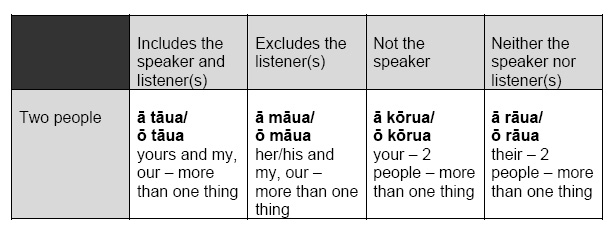Ngā Tohutohu
Possessive determiners, such as tā, tō, ā and ō, are used in combination with personal pronouns such as tāua, māua, rāua and kōrua. These possessive determiners, in combination with the personal pronouns, are used to show who has possession. These possessive determiners are also used to indicate whether there is one, or more than one, of the objects being talked about. To do this, the first t of the possessive determiner is omitted if there is more than one thing being spoken about, leaving ā or ō. Whether the ā or ō forms are used is determined by the relationship between the person and what is possessed.
If the possessor has, or had control of the relationship or is dominant, active or superior to what is owned, then the ā category is used
Hei tauira:
Kei reira ā māua tamariki. Our children are there.
In this situation the parents are superior to the children and therefore have or had, in a sense, control over the birth of their children.
If the possessor has, or had no control over the relationship or is subordinate, passive or inferior to what is owned, then the ō category is used.
Hei tauira:
Ko ēnei ō māua mātua. These are our parents.
In this situation the children are inferior to their parents and therefore have or had, in a sense, no control over their birth or the selection of their parents.
Along with these guidelines, the usual ā and ō category guidelines are also observed.
| Ā category |
Ō category |
|
Moveable property
Food or drink
Husband, wife, children, grandchildren
People in an inferior position
Animals, pets and crops
Active towards possessed
|
Part of anything, clothing, feelings, qualities
Transport
Water and Medicine
Habitation, buildings, seating, bedding
Land and towns
Companions, superiors, relatives (not husband, wife, children, grandchildren)
|

For further explanations and exercises: Te Kākano pp. 52-56, 140-142; Te Aka.
Whiriwhirihia ngā kupu tika hei whakakī i ngā āputa.